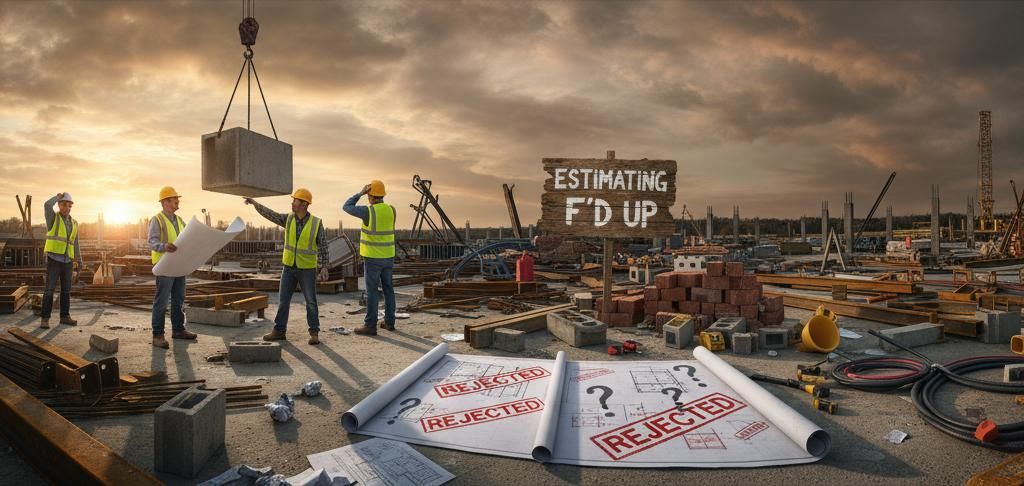Shifting as a Mid-Market to Upper-Market Construction Company
The Mindset Shifts That Make or Break You
The Challenge
Over the past 22 years, I've been in enough contractor offices to spot it right away. Many $25-$50 million companies have good reputations, steady work, and crews that know what they're doing. The owner isn't worried about making payroll anymore. They are thinking bigger.
But the stress has only shifted. Owners dream about stepping back, yet deep down they don’t trust anyone else to make the high-stakes calls. Or possibly they haven’t structured the company properly to do so. Teams are in place, but when the pressure hits, everyone still runs to ownership for answers. They’ve added more overhead, more estimators, more managers, yet the margins still aren’t improving. The weight sits heavily. The business has grown, but the owner is still carrying it on their shoulders.
This is what often happens when you're trying to jump from $25 million to $50 million, then $75 MM and so on. At this stage, you’re not just growing the company. You’re growing as leaders, learning to delegate, and shifting authority in ways that demand extreme accountability. It’s about running the business without having to stand in the middle of every decision. The question changes from "How do I build this business?" to "How do I build people who can run this thing without me?"
That's a hell of a shift, and most folks aren't ready for it.
The Impact
When you try to scale without changing how you think about your position in the company, everything starts breaking down. You feel like you're being pulled in ten directions because everyone still looks to you for answers, but you know damn well they should be figuring it out themselves.
Your PMs and estimators are all over the place with pricing and project execution because they don't have clear “rules” or the confidence to make calls. So you jump back in to fix it, which gets everyone annoyed and keeps you stuck doing the same stuff you were doing five, even 10 years ago!
All that technology you bought to make life easier? It's making life harder. Nothing talks to anything else, and now you've got three systems doing the same job badly instead of one system doing it right. Not to mention spending possibly over $100K a year in software that’s being underutilized.
Your margins stay flat or get worse even though you're doing more work. Every PM handles jobs differently, and that inconsistency is eating your lunch faster than growth can fix it.
Worst part is you can't keep good people or maximize them. They either leave because they don't see a future, or they stay but never step up to be the leaders you desperately need.
You keep asking yourself the same question: "How do I get out of the weeds without everything going to hell?"
I remember talking with a contractor a few months back who said they went from $30 MM to $75 MM last year. He said his revenue AND headaches doubled, BUT his profits stayed the same! This is the reality for many.
"Check out my latest podcast with Brian Brogen called Creating a Culture of Accountability in Construction here."
The Shift
Growing from $25 million to $50 million, then $100 million and beyond means changing what your job actually is. You stop being the person who knows everything and start being the leader who builds other employees who know everything.
Here's how you know if you're making that shift (or if you’re not). As these questions and carefully jot down the answers.
- Are your department heads making the calls you used to make, or do they still need your blessing for everything?
- Do you have numbers that show you how the business is really doing, or are you still walking around asking, "How's it going?
- Can your leadership team solve problems without you in the room?
- Are your estimators and PMs following the same process every time, or does every job get handled like it's the first one you've ever done? EX: Five PMs executing change orders five different ways, AND not your way, OR three estimators breaking down the same type of project for your review three different ways.
- Do you have a plan for the next year that actually guides decisions, or are you just taking whatever work shows up? Also, do your people actually know and believe in your plan, because if that’s not the case, you’ll NEVER successfully implement it. I’ll write a future newsletter on this.
- Are you working on the big picture stuff, or are you still putting out fires every day? At this stage, you need to be working on goals that drive future growth, not the day-to-day operations, unless it's critical.
- When someone quits, do you have someone ready to step up in that role, or do you panic?
- Do your financial reports tell you where you're headed (weekly and monthly), or just where you've been?
- Can you take a real vacation without your phone blowing up?
If you're still the center of everything, you're not building a company. You're just managing a bigger job.
Get clear on the above questions and create a plan of action for the next 12 months to shift from being reactive to proactive.
The Closing
The jump from mid-market to upper-market isn't only about doing more work or getting bigger jobs. It's also about changing what kind of leader you are. Because it ALWAYS starts with YOU!! You go from being the guy who built something to being the guy who builds other leaders.
If you're somewhere in the mid-market, or even upper market, and feeling the weight of this, you're not alone. Every contractor who's made this jump has felt the same thing. You want to grow, but you're scared to let go.
The owners and leaders who break through to the next level are the ones willing to change their whole identity while keeping your values intact, no matter what money pushes you to do! They stop being the person with all the answers and start being the leader who teaches other people to find the answers.
The market needs contractors who can operate at this level consistently. The question is whether you’re ready to build something that works even when you're not there to make it work.
Jerry Aliberti
Pro-Accel, Owner
Webinar Announcement!!
On November 13th at 11 am EST, I’ll be joining forces with Patrick Shurney, Financial Coach and Owner of 3P Consulting, to host From Builder to CEO — a paid masterclass that brings the financial and operational sides of contracting together.
This 90-minute session is built for contractors in the $5M–$100M range who want actionable steps, real deliverables, and immediate ROI. We’ll cover how to align your numbers and operations so you can step out of builder mode and into CEO mode.
- Ready to break free from the decision-making bottleneck and unlock your company's true growth potential? Pro-Accel's Executive Coaching program helps construction leaders build the systems and leadership capabilities that enable sustainable scaling. Reach out to
jerry@pro-accel.com to schedule a call and discuss how we can transform your operations.
- Enjoying this newsletter? Pass it along to your colleagues and friends, and have them sign up here: https://www.pro-accel.com/#Newsletter
If you like Jerry's insights, follow him on LinkedIn here:
linkedin.com/in/jerry-aliberti




